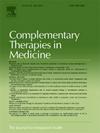Effects of traditional Chinese exercises on cardiopulmonary function in stroke patients: A meta-analysis
IF 3.5
3区 医学
Q1 INTEGRATIVE & COMPLEMENTARY MEDICINE
引用次数: 0
Abstract
Background
Traditional Chinese exercises may be effective in improving cardiorespiratory fitness in post-stroke patients; however, no study has conducted a meta-analysis to assess their its efficacy in meta.
Objective
The purpose of this meta-analysis is to evaluate how traditional Chinese exercises affect post-stroke cardiorespiratory fitness.
Methods
We conducted a comprehensive search across eight Chinese and English databases, including Wan Fang, VIP, CBM, PubMed, Embase, Web of Science, and the Cochrane Library, from the inception of these databases until May 2025. Our focus was on clinical randomized controlled trials related to stroke, cardiorespiratory function, and traditional Chinese exercises. After assessing the quality of the literature, we utilized Rev Man 5.4 software to analyze the data. Publication bias was assessed using funnel plots as well as Begg's and Egger's tests, employing Stata 17.0 software.
Results
A total of 23 studies were included in the analysis, and the results of the meta-analysis indicated that traditional Chinese exercises significantly improved cardiopulmonary function in post-stroke patients: pulmonary function indexes [FVC: SMD = 1.01, 95 %CI(0.66,1.35), I2= 88 %,P < 0.00001; FEV1: SMD = 1.22, 95 % CI (0.77,1.66), I2 = 91 %, P < 0.00001; PEF: SMD = 0.87, 95 % CI (0.53,1.21), I2= 83 %, P < 0.00001; MVV: MD = 9.65, 95 % CI (8.60,10.70), I2= 0 %, P = 0.55]; respiratory muscle function indexes [MIP: SMD = 0.72, 95 % CI (0.43,1.01) I2= 67 %, P = 0.001; MEP: SMD = 0.67, 95 %CI (0.49,0.86),I2 = 0 %, P = 0.55]; cardiac function index [LVEF: MD = 4.00, 95 % CI (2.28,5.72), I2 = 72 %, P = 0.01]; exercise endurance index [6MWT: MD = 4.49, 95 % CI (3.55,5.42), I2 = 0 %, P = 0.77]. No serious adverse events related to traditional Chinese exercises were reported. Only one study documented instances of patients experiencing panic attacks and shortness of breath, which resolved upon rest. Following a physician's examination, it was suggested that these symptoms may have been attributed to the patient's failure to consume breakfast, and no subsequent harm was reported.
Conclusions
Traditional Chinese exercise positively influences cardiorespiratory function in stroke patients, demonstrating the most significant improvements in athletic endurance and cardiac function. However, due to methodological flaws in the literature quality included in the study, there is a need for a multi-center, large-sample, and more rigorously designed experiment to validate these findings and ensure the accuracy of the results.
中国传统运动对脑卒中患者心肺功能的影响:荟萃分析。
背景:中医传统运动可能对脑卒中后患者的心肺功能有改善作用;然而,目前还没有研究进行meta分析来评估其疗效。目的:本荟萃分析的目的是评估中国传统运动对脑卒中后心肺健康的影响。方法:我们对万方、VIP、CBM、PubMed、Embase、Web of Science和Cochrane Library等8个中英文数据库进行了全面检索,检索时间从这些数据库建立到2025年5月。我们的重点是与中风、心肺功能和中国传统运动相关的临床随机对照试验。在评估文献质量后,我们使用Rev Man 5.4软件对数据进行分析。采用Stata 17.0软件,采用漏斗图以及Begg’s和Egger’s检验评估发表偏倚。结果:共纳入23项研究,荟萃分析结果显示,中医运动显著改善脑卒中后患者心肺功能:肺功能指标[FVC: SMD = 1.01, 95%CI(0.66,1.35), I2=88%,P2 = 91%, P2=83%, P < 0.00001;MVV: MD = 9.65, 95% CI (8.60, 10.70), I2 = 0%, P = 0.55);呼吸肌功能指数[MIP: SMD = 0.72, 95% CI (0.43,1.01) I2=67%, P = 0.001;议员:SMD = 0.67, 95% ci (0.49, 0.86), I2 = 0%, P = 0.55);心功能指数[LVEF: MD = 4.00, 95% CI (2.28,5.72), I2 = 72%, P = 0.01];运动耐力指数[6MWT: MD = 4.49, 95% CI (3.55,5.42), I2 = 0%, P = 0.77]。未见与中国传统运动相关的严重不良事件的报道。只有一项研究记录了患者出现惊恐发作和呼吸短促的情况,这些情况在休息后就会消失。医生检查后认为,这些症状可能是由于病人没有吃早餐造成的,但没有报告随后的伤害。结论:中医运动对脑卒中患者心肺功能有积极影响,其中运动耐力和心功能的改善最为显著。然而,由于纳入研究的文献质量存在方法学上的缺陷,需要进行多中心、大样本和更严格设计的实验来验证这些发现并确保结果的准确性。
本文章由计算机程序翻译,如有差异,请以英文原文为准。
求助全文
约1分钟内获得全文
求助全文
来源期刊

Complementary therapies in medicine
医学-全科医学与补充医学
CiteScore
8.60
自引率
2.80%
发文量
101
审稿时长
112 days
期刊介绍:
Complementary Therapies in Medicine is an international, peer-reviewed journal that has considerable appeal to anyone who seeks objective and critical information on complementary therapies or who wishes to deepen their understanding of these approaches. It will be of particular interest to healthcare practitioners including family practitioners, complementary therapists, nurses, and physiotherapists; to academics including social scientists and CAM researchers; to healthcare managers; and to patients. Complementary Therapies in Medicine aims to publish valid, relevant and rigorous research and serious discussion articles with the main purpose of improving healthcare.
 求助内容:
求助内容: 应助结果提醒方式:
应助结果提醒方式:


